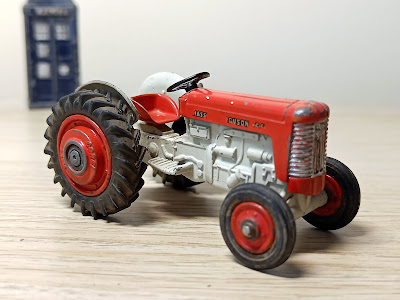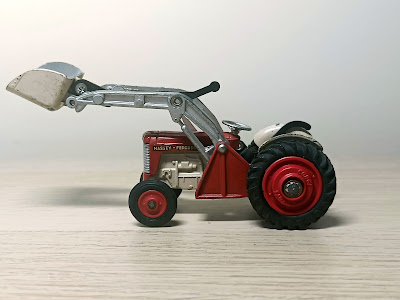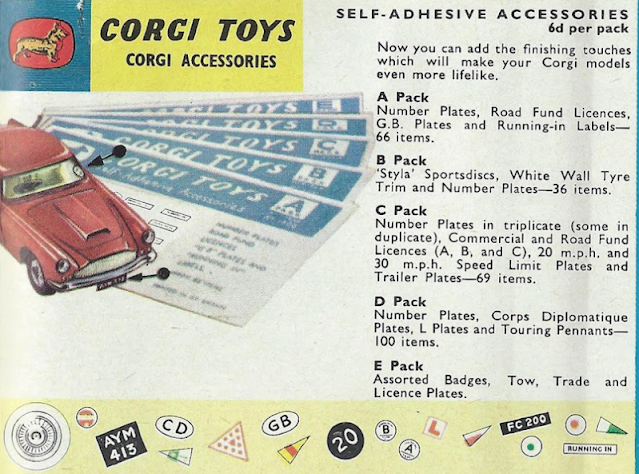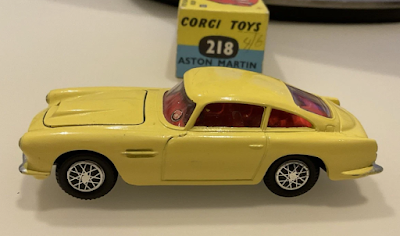In May 1959 we saw the first farming issues from Corgi. This was the Massey Ferguson 65 tractor in its 'Massey Ferguson' red finish. For the first edition, that included the seat too.
Later the seat gets painted in the cream or pinky-cream of the chassis and eventually they settle for not painting it at all.
The wheels start off as metal but get replaced by plastic at some stage.
The steering wheel also starts as black but is replaced by a silver metal one. I have no idea when all these changes are made. The vast majority of models have silver seat, steering wheel and plastic wheels as well as gold lettering in the transfers. I have seen silver / white lettering and also a brighter gold which looks more like yellow but I am unsure whether these are merely replacements as parts suppliers can provide these now and many are difficult to distinguish from the originals.
Corgi concentrated on just two brands - Massey Ferguson and Fordson. In this article I will show you the Massey Ferguson tractors. There was also a 'Massey Ferguson' trailer issued in May 1959 and in October a marvellous Massey Ferguson Combine Harvester which I will return to another day.
The #50 tractor was also issued in Gift Set 7 (with the #51 Trailer), Gift Set 8 (with the #51 trailer and #1111 Combine Harvester and Gift Set 29 (with the #51 Trailer with a driver added).
The next tractor was in April 1960 when a shovel gets attached to the tractor as #53.
This is a typical example of Corgi's detailed production of operational pieces. With the two levers you could raise and lower the arms and hold or let the bucket swing down to empty it. With a pile of sand or bits and pieces you really could pick stuff up and transport it to be dropped somewhere else - well, as long as you didn't need to turn any sharp corners as all the Massey Ferguson tractors had fixed axles.
The first shovel attachment model #53 has cream arms and the transfers are fitted along them with none on the tractor bonnet. It has metal wheels.
At some point the arms section is revised, with an additional bar between them and now there is no space for the transfer so it returns to the tractor bonnet. I believe this version will always have plastic wheels but there is no definitive evidence that the wheels were changed at exactly the same time as the lift mechanism so there may be a further two variations: arms type 1 with plastic wheels, arms type 2 with metal wheels.
Near the end of production comes a known third variety. This one has bare metal arms but is otherwise in the same style as the previous one, with transfers on the bonnet. I am sure all of these will have plastic wheels.
This also appears in Gift Set 32 with a #62 Trailer with raves and has a driver.
In May 1963 the Massey Ferguson 65 tractor gets a fork attachment (available to buy as #57 in a box). This always seems to be in bare metal, very much along the lines of the final Shovel attachment.
This is also included in Gift Set 22 where, in fact, it first appeared in September 1962. There are some errors in some publications which list Gift Set 22 as having #53 not #57. I had unwittingly taken my data from these supposedly reputable sources too and have only just changed my site in that respect! Because the Shovel version was the one available at the time of the Set's issue it seemed logical to conclude that they set had #53 not #57. Now, of course, we may find that could, indeed be the case but all the new-looking sets I have seen have had the Fork attachment.
In July 1966 there is a new Massey Ferguson - the 165.
This looks similar in its traditional red but now has a grey chassis which makes the white grille surround stand out. There is an exhaust too and a driver from the start.
On the front axle is a device which makes an approximation to a chugging sound - perhaps not one of Corgi's brightest of ideas. Steering would have been a better idea, or some jewels for the headlamps like they gave to the later Ford tractor.
On its own, the Massey Ferguson 165 tractor as #66 doesn't get into any Gift Sets.
In March 1967 the 165 gets a shovel attachment, very similar to the last fork attachment but with red arms and a bare metal, more angular bucket for #69 than was fitted to #53.
This edition does find its way into two Gift Sets: the big Agricultural Gift Set 5 in October 1967 and Gift Set 9 in December 1968 with the #62 trailer.
Then we get a bit of a surprise in March 1970 when a most impressive #73 165 Tractor is issued with a working rotating saw attachment.
This is remarkable bit of engineering that uses a tightly coiled wire (essentially a spring) to translate the rotation of rear wheel teeth to turn the spring and hence the saw at the other end. As well as detailed controls and 'hydraulic' piping the attachment and arm can be positioned in many ways and there is even a safety guard in a heavy metal mesh design too.
This is not quite the end of the Massey Ferguson story as in 1973 there is a new #50 in the shape of a Massey Ferguson MF50B Tractor which gets a shovel in May 1974. These are appalling models, very basic and with such limited detailing that I don't care for them much at all. There are some interesting sets in which they appear, however, so I will write about them on another occasion. Better to end on the high note that was #73.































.jpg)
.jpg)




.jpg)

.jpg)













